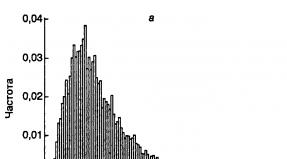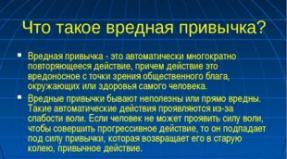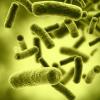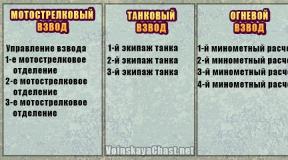Types of corona discharges. Types of discharges and their application. Air ionization theory
Types of gas discharge and their application. The concept of plasma.
Branch:
Accounting and Law
Specialty:
Jurisprudence
Group:
Made up:
A. A. Evtikhevich
Teacher:
Orlovskaya G.V.
2011
Content:
Page 1: Gas discharge
Gas discharge application
Page 2:Spark discharge
Corona discharge
Page 3:Application of corona discharge
Page 4: Arc discharge
Page 5:Arc discharge application
Glow discharge
Page 6-7:Plasma
Page 8:Literature
Gas discharge - a set of processes that occur when an electric current flows through a substance in a gaseous state. Typically, the flow of current becomes possible only after sufficient ionization of the gas and the formation of plasma. Ionization occurs due to collisions of electrons accelerated in an electromagnetic field with gas atoms. In this case, an avalanche increase in the number of charged particles arises, since in the process of ionization new electrons are formed, which also after acceleration begin to participate in collisions with atoms, causing their ionization. For the occurrence and maintenance of a gas discharge, the existence of an electric field is required, since a plasma can exist only if the electrons acquire in an external field energy sufficient to ionize atoms, and the number of formed ions exceeds the number of recombined ions.
If the existence of a gas discharge requires additional ionization due to external sources (for example, using ionizing radiation), then the gas discharge is called dependent (such discharges are used in Geiger counters).
To carry out a gas discharge, both constant in time and alternating electric fields are used.
Depending on the conditions under which the formation of charge carriers occurs (gas pressure, voltage applied to the electrodes, the shape and temperature of the electrodes), several types of self-sustained discharges are distinguished: smoldering, spark, corona, arc.
Gas discharge applications
- Arc discharge for welding and lighting.
- Ultrahigh-frequency discharge.
- Glow discharge as a light source in fluorescent lamps and plasma screens.
- Spark discharge for ignition of the working mixture in internal combustion engines.
- Corona discharge for cleaning gases from dust and other contaminants, for diagnosing the state of structures.
- Plasma torches for cutting and welding.
- Discharges for pumping lasers such as helium-neon lasers, nitrogen lasers, excimer lasers, etc.
- in a Geiger counter,
- in ionization vacuum gauges,
- in thyratrons,
- in krytrons,
- in a Geisler tube.
Spark discharge... Let's attach the ball electrodes to the capacitor bank and start charging the capacitors with an electric machine. As the capacitors are charged, the potential difference between the electrodes will increase, and therefore, the field strength in the gas will increase. As long as the field strength is low, no change can be seen in the gas. However, with a sufficient field strength (about 30,000 V / cm), an electric spark appears between the electrodes, in the form of a brightly glowing tortuous channel connecting both electrodes. The gas near the spark heats up to a high temperature and suddenly expands, causing sound waves and we hear a characteristic crackle. The capacitors in this installation are added to make the spark more powerful and therefore more effective.
The described form of gas discharge is called spark discharge, or spark breakdown of gas. With the onset of a spark discharge, the gas suddenly, abruptly, loses its insulating properties and becomes a good conductor. The field strength at which a spark gas breakdown occurs has a different value for different gases and depends on their state (pressure, temperature). At a given voltage between the electrodes, the farther the electrodes are from each other, the lower the field strength. Therefore, the greater the distance between the electrodes, the greater the voltage between them is necessary for the onset of spark gas breakdown. This voltage is called breakdown voltage. The breakdown is explained as follows. There is always a certain amount of ions and electrons in a gas, arising from random causes. Usually, however, their number is so small that the gas practically does not conduct electricity. At relatively low values \u200b\u200bof the field strength, which we encounter when studying the non-self-sustaining conductivity of gases, the collisions of ions moving in an electric field with neutral gas molecules occur in the same way as collisions of elastic balls. At each collision, the moving particle transfers to the resting part of its kinetic energy, and both particles fly away after the impact, but no internal changes occur in them. However, with a sufficient field strength, the kinetic energy accumulated by an ion in the interval between two collisions can become sufficient to ionize a neutral molecule upon collision. As a result, a new negative electron and a positively charged residue - an ion - are formed. Such an ionization process is called impact ionization, and the work that needs to be spent to remove an electron from an atom is the work of ionization. The amount of work of ionization depends on the structure of the atom and therefore is different for different gases. The electrons and ions formed under the influence of impact ionization increase the number of charges in the gas, and, in turn, they come into motion under the action of an electric field and can produce impact ionization of new atoms. Thus, this process "amplifies itself" and ionization in the gas quickly reaches a very high value. All phenomena are quite analogous to an avalanche in the mountains, for the origin of which an insignificant lump of snow is enough. Therefore, the described process was called an ionic avalanche. The formation of an ion avalanche is the spark breakdown process, and the minimum voltage at which an ion avalanche occurs is the breakdown voltage. We see that in a spark breakdown, the cause of gas ionization is the destruction of atoms and molecules in collisions with ions. One of the natural representatives of a spark discharge is lightning - beautiful and unsafe.
Corona discharge... The appearance of an ion avalanche does not always lead to a spark, but can also cause a discharge of another type - a corona discharge. We stretch a metal wire AB with a diameter of a few tenths of a millimeter on two high insulating supports and connect it to the negative pole of a generator that gives a voltage of several thousand volts, for example, a good electrical machine. Let's take the second pole of the generator to the Earth. We will get a kind of capacitor, the plates of which are our wire and the walls of the room, which, of course, communicate with the Earth. The field in this capacitor is very inhomogeneous, and its strength is very high near a thin wire. Gradually increasing the voltage and observing the wire in the dark, one can notice that at a known voltage, a weak glow ("crown") appears near the wire, covering the wire from all sides; it is accompanied by a hissing sound and a slight crackling sound. If a sensitive galvanometer is connected between the wire and the source, then with the appearance of a glow, the galvanometer shows a noticeable current going from the generator through the wires to the wire and from it through the room air to the walls connected to the other pole of the generator. The current in the air between the AB wire and the walls is carried by the ions generated in the air due to impact ionization. Thus, the glow of the air and the appearance of a current indicate a strong ionization of the air by the action of an electric field. A corona discharge can occur not only at the wire, but also at the tip and, in general, at all electrodes, near which a very strong nonuniform field is formed.
Application of corona discharge
1) Electric gas cleaning (electrostatic precipitators). A vessel filled with smoke is suddenly made completely transparent when sharp metal electrodes are inserted into it, connected to an electric machine. The glass tube contains two electrodes: a metal cylinder and a thin metal wire hanging along its axis. The electrodes are connected to an electrical machine. If you blow a stream of smoke (or dust) through the tube and start the machine, then, as soon as the voltage becomes sufficient to form a corona, the outgoing air stream will become completely clean and transparent, and all solid and liquid particles contained in the gas will settle on electrodes.
The explanation of the experience is as follows. As soon as the crown is ignited at the wire, the air inside the tube is highly ionized. Gas ions, colliding with dust particles, "stick" to the latter and charge them. Since a strong electric field acts inside the tube, the charged particles move under the action of the field to the electrodes, where they settle. The described phenomenon finds itself at the present time technical application for the purification of industrial gases in large volumes from solid and liquid impurities.
2) Counters of elementary particles. Corona discharge underlies the operation of extremely important physical devices: the so-called counters of elementary particles (electrons, as well as other elementary particles that are formed during radioactive transformations). One of the types of counter (Geiger-Muller counter) is shown in Fig. 1.
It consists of a small metal cylinder A, provided with a window, and a thin metal wire stretched along the axis of the cylinder and insulated from it. The meter is included in a circuit containing a voltage source V of several thousand volts. The voltage is chosen so that it is only slightly less than the "critical" voltage, that is, required to ignite a corona discharge inside the meter. When a fast moving electron enters the counter, the latter ionizes the gas molecules inside the counter, which causes the voltage required to ignite the corona to decrease somewhat. A discharge occurs in the counter, and a weak short-term current appears in the circuit.
The current generated in the meter is so weak that it is difficult to detect it with an ordinary galvanometer. However, it can be made quite noticeable if a very large resistance R is introduced into the circuit and a sensitive electrometer E is connected in parallel to it. When a current I appears in the circuit, a voltage U is created at the ends of the resistance, equal to U \u003d IxR according to Ohm's law. If we choose a resistance value R that is very large (many millions of ohms), but much less than the resistance of the electrometer itself, then even a very weak current will cause a noticeable voltage. Therefore, with each hit of a fast electron inside the counter, the sheet of the electrometer will give off a rejection.
Such counters make it possible to register not only fast electrons, but in general any charged, fast moving particles capable of ionizing a gas by collisions. Modern counters easily detect the ingress of even one particle into them and allow, therefore, with full reliability and very high clarity, make sure that elementary particles really exist in nature.
Arc discharge... In 1802, V.V.Petrov established that if you attach two pieces of charcoal to the poles of a large electrolytic battery and, bringing the coals into contact, slightly separate them, then a bright flame forms between the ends of the coals, and the ends of the coals themselves glow white. Emitting blinding light (electric arc). This phenomenon was independently observed seven years later by the English chemist Davy, who proposed to name this arc "voltaic" in honor of Volta.
Typically, the lighting network is powered by alternating current. The arc, however, burns more steadily if a constant current is passed through it, so that one of its electrodes is always positive (anode), and the other negative (cathode). Between the electrodes there is a column of hot gas that conducts electricity well. In conventional arcs, this pillar emits significantly less light than red-hot coals. Positive coal, having a higher temperature, burns faster than negative one. Due to the strong sublimation of coal, a depression forms on it - a positive crater, which is the hottest part of the electrodes. The crater temperature in air at atmospheric pressure reaches 4000 ° C.
The arc can also burn between metal electrodes (iron, copper, etc.). In this case, the electrodes melt and quickly evaporate, which consumes a lot of heat. Therefore, the crater temperature of a metal electrode is usually lower than that of a coal one (2000-2500 ° C).
Forcing the arc between the carbon electrodes to burn in compressed gas (about 20 atm), it was possible to bring the temperature of the positive crater to 5900 ° C, i.e., to the temperature of the sun's surface. Under this condition, coal melting was observed.
An even higher temperature is possessed by a column of gases and vapors, through which an electric discharge occurs. Vigorous bombardment of these gases and vapors with electrons and ions, driven by the electric field of the arc, brings the temperature of the gases in the column up to 6000-7000 °. Therefore, in the arc column, almost all known substances melt and turn into steam, and many chemical reactions are made possible that do not take place at lower temperatures. It is not difficult, for example, to melt refractory porcelain sticks in an arc flame.
To maintain the arc discharge, a small voltage is needed: the arc burns well when the voltage on its electrodes is 40-45 V. The arc current is quite significant. So, for example, even in a small arc, a current of about 5 A flows, and in large arcs used in industry, the current reaches hundreds of amperes. This shows that the arc resistance is low; therefore, the glowing gas column conducts electric current well.
Such a strong ionization of the gas is possible only due to the fact that the cathode of the arc emits a lot of electrons, which by their impacts ionize the gas in the discharge space. Strong electron emission from the cathode is ensured by the fact that the arc cathode itself is heated to a very high temperature (from 2200 ° to 3500 ° C depending on the material). When, to ignite the arc, we first bring the coals into contact, then at the point of contact, which has a very high resistance, almost all the Joule heat of the current passing through the coals is released. Therefore, the ends of the coals are very hot, and this is enough for an arc to flare up between them when they move apart. Subsequently, the cathode of the arc is maintained in a heated state by the current itself passing through the arc. The main role in this is played by the bombardment of the cathode by positive ions incident on it.
Arc discharge application
Due to the high temperature, the arc electrodes emit dazzling light, and therefore the electric arc is one of the best light sources. It only consumes about 0.3 watts per candle and is significantly more economical. Not the best incandescent bulbs. The electric arc was first used for lighting by PN Yablochkov in 1875 and received the name "Russian light", or "northern light".
The electric arc is also used for welding metal parts (electric arc welding). Currently, the electric arc is widely used in industrial electric furnaces. In global industry, about 90% of tool steel and almost all specialty steels are smelted in electric furnaces.
Of great interest is a mercury arc burning in a quartz tube, the so-called quartz lamp. In this lamp, the arc discharge occurs not in air, but in an atmosphere of mercury vapor, for which a small amount of mercury is introduced into the lamp, and the air is pumped out. The light of the mercury arc is extremely rich in invisible ultraviolet rays with strong chemical and physiological effects. Mercury lamps are widely used in the treatment of various diseases ("artificial mountain sun"), as well as in scientific research as a strong source of ultraviolet rays.
Glow discharge... In addition to the spark, corona and arc, there is another form of self-sustained discharge in gases - the so-called glow discharge. To obtain this type of discharge, it is convenient to use a glass tube about half a meter long, containing two metal electrodes. Let's connect the electrodes to a direct current source with a voltage of several thousand volts (an electric machine is suitable) and we will gradually pump out air from the tube. At atmospheric pressure, the gas inside the tube remains dark, since the applied voltage of several thousand volts is not enough to break through the long gas gap. However, when the gas pressure drops enough, a luminous discharge flares up in the tube. It looks like a thin cord (in the air - crimson, in other gases - other colors) connecting both electrodes. In this state, the gas column conducts electricity well.
Upon further evacuation, the luminous cord diffuses and expands, and the glow fills almost the entire tube. The following two parts of the discharge are distinguished: 1) the non-luminous part adjacent to the cathode, called the dark cathode space; 2) a luminous column of gas that fills the rest of the tube, right up to the anode itself. This part of the discharge is called the positive column.
And this is how it works. With a glow discharge, the gas conducts electricity well, which means that strong ionization is maintained in the gas all the time. In this case, in contrast to an arc discharge, the cathode remains cold all the time. Why does the formation of ions occur in this case?
The potential or voltage drop at each centimeter of the length of the gas column in a glow discharge is very different in different parts of the discharge. It turns out that almost all the potential drop occurs in the dark space. The potential difference that exists between the cathode and the space boundary nearest to it is called the cathode potential drop. It is measured in hundreds, and in some cases thousands of volts. The entire discharge appears to exist due to this cathode drop.
The significance of the cathode fall lies in the fact that positive ions, running through this large potential difference, acquire a high velocity. Since the cathode fall is concentrated in a thin layer of gas, there are almost no collisions of ions with gas atoms, and therefore, passing through the region of cathode fall, ions acquire a very large kinetic energy. As a result, when they collide with the cathode, they knock out a number of electrons from it, which begin to move towards the anode. Passing through the dark space, the electrons, in turn, are accelerated by the cathodic potential drop, and upon collision with gas atoms in the more distant part of the discharge, they produce impact ionization. The resulting positive ions are again accelerated by the cathode fall and knock out new electrons from the cathode, etc. Thus, everything is repeated as long as there is voltage on the electrodes.
This means that we see that the causes of gas ionization in a glow discharge are impact ionization and positive ions knocking out electrons from the cathode.
This discharge is used mainly for lighting. It is applied in fluorescent lamp.
The word "plasma" (from the Greek. "Plasma" - "shaped") in the middle of the XIX century. began to call the colorless part of blood (without red and white bodies) and the liquid that fills living cells. In 1929, the American physicists Irving Langmuir (1881-1957) and Levi Tonko (1897-1971) called the ionized gas plasma in a gas-discharge tube. English physicist William Crookes (1832-1919), who studied electrical discharge in tubes with rarefied air, wrote: "The phenomena in evacuated tubes open up a new world for physical science in which matter can exist in the fourth state." Any substance changes its state depending on the temperature. So, water at negative (Celsius) temperatures is in a solid state, in the range from 0 to 100 "C - in a liquid state, above 100 ° C - in a gaseous state. If the temperature continues to rise, atoms and molecules begin to lose their electrons - they are ionized and gas turns into plasma. At temperatures above 1,000,000 ° C, plasma is absolutely ionized - it consists only of electrons and positive ions. Plasma is the most common state of matter in nature, it accounts for about 99% of the mass of the Universe. The sun, most stars, nebulae - this is a fully ionized plasma. The outer part of the earth's atmosphere (ionosphere) is also plasma. Even higher are the radiation belts containing plasma. Auroras, lightning, including ball, - all these are different types of plasma that can be observed in natural conditions on Earth .And only an insignificant part of the Universe is matter in a solid state - planets, asteroids and dust nebulae. In physics, plasma is understood as a gas consisting of from electrically charged and neutral particles, in which the total electric charge is zero, i.e. the condition of quasi-neutrality is satisfied (therefore, for example, a beam of electrons flying in a vacuum is not a plasma: it carries a negative charge). PLASMA is a partially or fully ionized gas in which the densities of positive and negative charges are practically the same. In laboratory conditions, plasma is formed in an electric discharge in a gas, in combustion and explosion processes. When the laser beam was focused by a lens, a spark flashed in the air in the focus area, and a plasma was formed there. This aroused great interest among physicists. The first seed electrons appear as a result of tearing them out of the atoms of the medium after the simultaneous absorption of several photons of the light wave. The energy of each photon in a ruby \u200b\u200blaser is 1.78 eV. Further, a free electron, absorbing photons, reaches an energy of 10 eV, which is sufficient for ionization and creation of a new electron in the process of collision with atoms of the medium. The discharge can burn for a long time and glows with a dazzling white light, it is impossible to look at it without dark glasses. The unusually high temperature, a unique property of an optical charge, offers great opportunities for using it as a light source. The possibility of creating a plasma filament by the light of a laser opens up possibilities for transferring energy over a distance. Charge carriers in plasma are electrons and ions formed as a result of gas ionization. The ratio of the number of ionized atoms to their total number per unit volume of plasma is called the degree of plasma ionization (a). Depending on the value of a, one speaks of weakly ionized (a - fractions of a percent), partially ionized (a - several percent) to fully ionized (a is close to 100%) plasma. The average kinetic energies of different types of particles that make up the plasma can be different. Therefore, in the general case, plasma is characterized not by one temperature value, but by several - they distinguish between the electron temperature Te, the ionic temperature Ti and the temperature of neutral atoms Ta. Plasma with ion temperature Ti< 105 К называют низкотемпературной, а с Тi > 106 K - high temperature. High-temperature plasma is the main object of research in CTS (controlled thermonuclear fusion). Low-temperature plasma is used in gas-discharge light sources, gas lasers, MHD - generators, etc. Plasma is most widely used in lighting engineering - in gas-discharge lamps that illuminate streets and fluorescent lamps used in rooms. And besides, in a wide variety of gas-discharge devices: electric current rectifiers, voltage stabilizers, plasma amplifiers and microwave generators, cosmic particle counters. All the so-called gas lasers (helium-neon, krypton, carbon dioxide, etc.) are actually plasma: gas mixtures in them are ionized by an electric discharge. Properties characteristic of plasma are possessed by conduction electrons in a metal (ions rigidly fixed in the crystal lattice neutralize their charges), a set of free electrons and mobile "holes" (vacancies) in semiconductors. Therefore, such systems are called plasma of solids. Gas plasma is usually divided into low-temperature - up to 100 thousand degrees and high-temperature - up to 100 million degrees. There are generators of low-temperature plasma - plasmatrons that use an electric arc. With the help of a plasmatron, it is possible to heat almost any gas to 7000-10000 degrees in hundredths and thousandths of a second. With the creation of the plasmatron, a new field of science arose - plasma chemistry: many chemical reactions are accelerated or only occur in a plasma jet. Plasma torches are used both in the mining industry and for cutting metals. Plasma engines and magnetohydrodynamic power plants have also been created. Various schemes of plasma acceleration of charged particles are being developed. The central task of plasma physics is the problem of controlled thermonuclear fusion. Thermonuclear reactions are called fusion reactions of heavier nuclei from the nuclei of light elements (primarily hydrogen isotopes - deuterium D and tritium T), which occur at very high temperatures (»108 K and above). In natural conditions, thermonuclear reactions occur on the Sun: hydrogen nuclei combine with each other with a friend, forming helium nuclei, while releasing a significant amount of energy. An artificial thermonuclear fusion reaction was carried out in a hydrogen bomb.
Literature
- McDonald A. Ultrahigh-frequency breakdown in gases. Moscow: Mir, 1969.205 p.
· Vladimir Zhdanov Plasma. Around the World.
· Vladimir Zhdanov Plasma in space. Around the world
· Raizer Yu. P. Physics Raizer Yu. P. Gas discharge physics of gas discharge
The gas discharge is called independentif it continues even after the external ionizer stops operating. The formation of free charges in a gas during a self-discharge occurs due to processes caused by the action of an electric field. Depending on the type of discharge, in addition to impact ionization, it can be knocking out electrons from the cathode by positive ions, photoionization and thermal ionization of a gas, thermionic emission, and cold electron emission. The voltage at which the transition of a non-self-sustained discharge to an independent one occurs is called ignition voltage or breakdown voltage... Its value depends on the cathode material, the chemical nature of the gas, the presence of impurities in the gas, the gas pressure, the distance between the electrodes, their shape and size.
Let us estimate the effect of electron avalanches on the current in a gas discharge (Fig. 61.1). Let free electrons form around the cathode every second. On distance x from the cathode, their number is p... In layer dx as a result of impact ionization, dnfree electrons. Obviously dn~ dxand dn~ n.Then you can write: dn ~ n dx.Passing to equality, we obtain
where α is the impact ionization coefficient.
From formula (61.1) we obtain
After performing the integration, we find:
Integration constant value FROMwe find by substituting into formula (61.2) and :
Let's combine formulas (61.2) and (61.3):
After ഻ క (that̠ 䐒 ѩp 䐾 let us potentiate the resulting expression:
As follows from the obtained formula, with increasing distance x from the cathode, the number of free electrons increases exponentially.
If there was no impact ionization, every second the anode would reach electrons and a saturation current would arise, the strength of which (section Sun in Figure 60.2). As a result of impact ionization of the anode, it reaches electrons every second and the current strength becomes equal, i.e., times greater (section CD in Figure 60.2).
The occurrence of electronic avalanches is a prerequisite for the ignition of a self-sustained discharge. However, this process alone is not enough, since the appearance of primary electrons near the cathode is required, which will cause the formation of electron avalanches. The appearance of these electrons can occur due to thermionic emission, cold electron emission, knocking out electrons from the cathode by positive ions and other processes caused by the action of an electric field.
There are four types of self-discharge depending on the gas pressure, electrode configuration, and external circuit parameters:
Smoldering;
Iskrova;
Arc;
Crown.
When describing them, we will indicate under what conditions they arise, due to what processes ions and electrons are formed, what light and sound effects are accompanied by and where they find practical application.
Glow discharge arises in rarefied gases at a pressure of several millimeters of mercury and a voltage of the order of V. Free charges are formed due to impact ionization and knockout of electrons from the cathode by positive ions. The current in a glow discharge is usually small. The discharge is accompanied by a not very bright glow arising from the recombination of ions and the transition of excited atoms to the normal state. A glow discharge is used in signal neon lamps, digital indicator lamps, zener diodes.
Spark discharge init occurs at normal and high pressures, when the field strength reaches the value of the dielectric strength of the gas. At atmospheric pressure for air, it is 30 kV / cm. After breakdown, the channel resistance is small and a large current pulse passes through it. If the power of the source is low, then the discharge stops. The voltage rises again and the spark jumps again. The gas in the channel heats up, its pressure rises sharply and a shock wave arises. The discharge is accompanied by a loud cracking sound and a bright intermittent glow. An example of a spark discharge is lightning, in which the spark channel can reach a length of up to 10 km with a diameter of up to 40 cm. The current reaches A, the temperature up to K, and the pressure up to Pa.
With a spark discharge near the cathode, an electron avalanche arises, which on its way ionizes and excites gas molecules. Photons emitted by excited molecules produce photoionization and give rise to new electron avalanches. Individual electron avalanches catch up with each other and, merging together, form a highly ionized channel (streamer) through which the current flows.
The high temperature and pressure in the spark discharge make it possible to use it for electric spark processing of metal, in ignition systems of internal combustion engines. The spark discharge is also used in spark voltmeters, spark gaps.
Arc discharge between two carbon electrodes was discovered by the Russian physicist V.V. Petrov in 1802. It occurs at any pressure at a voltage of several tens of volts. The current in the arc can reach tens and hundreds of amperes. The spark discharge turns into an arc discharge at a sufficiently high source power and a small distance between the electrodes.
During an arc discharge, the electrodes (especially the anode) become very hot. Thermionic emission occurs from the cathode. In the discharge itself, thermal ionization and photoionization of the gas are observed. A cold cathode arc (usually in mercury vapor) is maintained by cold emission of electrons from the cathode and impact ionization of the gas.
The arc discharge was first used by P. N. Yablochkov, who in 1876 created arc lamps ("Yablochkov's candle"). In 1882 N.N. Benardos implemented the use of an arc discharge with a carbon electrode for cutting and welding metals. In 1888 g.
NG Slavyanov improved this method by replacing the carbon electrode with a metal one.
Cold cathode arc discharge is a source of ultraviolet radiation, which explains its use in quartz and fluorescent lamps. It is also used in thyratrons, gasotrons, arc fuses.
Corona discharge arises at atmospheric pressure in a strongly inhomogeneous electric field, i.e., near electrodes with a large curvature. When the electric field near the electrode reaches about 3 ∙ V / m, a glow appears around it, which looks like a shell or corona, from which the name of the charge originated. A second electrode is optional, but surrounding, grounded metal objects can play this role.
A negative corona discharge is maintained due to impact ionization and the knocking out of electrons from the cathode by positive ions, a positive one - due to photoionization.
Corona discharge in high voltage transmission lines leads to energy losses. To reduce corona formation, the radius of the conductors is increased, and their surface is made smooth. Corona discharge is used in smoke electrostatic precipitators, when printing on paper and other materials using an electronic-graphic method.
Depending on the gas pressure, voltage applied to the electrodes, the shape and nature of the arrangement of the electrodes, the following types of self-discharge are distinguished: glow, corona, arc and spark.
Glow discharge observed at low gas pressures (about 0.1 mm Hg). If a constant voltage of several hundred volts is applied to the electrodes soldered into a glass tube and then gradually air is pumped out of the tube, then the following phenomenon is observed: when the gas pressure decreases at a certain moment, a discharge appears in the tube in the form of a glowing cord connecting the anode and cathode tubes (fig. 1). With a further decrease in pressure, this cord expands and fills the entire cross section of the tube, and the glow near the cathode weakens. The first dark space forms near the cathode 1 adjacent to the ionic luminous layer 2 (glowing glow), which has a sharp boundary from the cathode side and gradually disappears from the anode side. Behind the glowing glow, there is again a dark gap 3 called Faraday or Second Dark Space. Behind it lies a luminous area 4 extending to the anode, or positive post.
Of particular importance in a glow discharge are only two of its parts - the cathode dark space and the glowing glow, in which the main processes supporting the discharge take place. The electrons that ionize the gas are generated by photoemission from the cathode and collisions of positive ions with the cathode of the tube.
Glow discharge is now widely used as a light source in various gas tubes. In daylight sources, the discharge usually occurs in mercury vapor. Gas pipes are also used for advertising and decorative purposes.
Glow discharge is used for cathode sputtering of metals, since the cathode substance in a glow discharge gradually turns into a gaseous state and settles in the form of metal dust on the tube walls. Placing various objects into the glow discharge, cover them with uniform and durable layers of metal. This method is used to make high quality metal mirrors.
Spark dischargeoften seen in nature is lightning. Lightning is a discharge between two charged clouds or between a cloud and the ground. Charge carriers in clouds are charged water droplets or snowflakes.
Under laboratory conditions, a spark discharge can be obtained by gradually increasing the voltage between two electrodes located in atmospheric air and having such a shape that the electric field between them differs little from a uniform one. At a certain voltage, an electrical spark is generated. In this case, the spark discharge penetrates the discharge gap with great speed, extinguishes and reappears. The brightly glowing curved channel of the spark connects both electrodes and has a complex branching (Fig. 2). The glow in the spark is the result of intense ionization processes. The sound effects accompanying the spark are generated by an increase in pressure (up to hundreds of atmospheres) due to the heating of the gas (up to 10 5 ° C) in the places where the discharge passes. A spark occurs when the electric field in a gas reaches a certain definite value, which depends on the type of gas and its state.
If, while keeping the voltage constant, the distance between the electrodes is reduced, then the field strength in the gas gap will increase. At a certain value, a spark discharge will occur. The higher the applied voltage, the greater the distance between the electrodes at which a spark discharge will occur. The principle of operation of a spark voltmeter - a device for measuring very high voltages - is based on this very phenomenon.
Arc discharge can be observed under the following conditions: if, after the ignition of the spark discharge, the resistance of the circuit is gradually reduced, then the current in the spark will increase. When the resistance of the circuit becomes small enough, a new form of gas discharge, called arc discharge, will arise. In this case, the current strength increases sharply, reaching tens and hundreds of amperes, and the voltage across the discharge gap decreases to several tens of volts. This shows that new processes appear in the discharge, imparting very high electrical conductivity to the gas.
At present, an electric arc burning at atmospheric pressure is most often produced between special carbon electrodes. The hottest spot in the arc is a depression in the positive electrode called an arc crater. Its temperature at atmospheric pressure is about 4000 ° C.
The electric arc is a powerful light source and is widely used in projection, floodlight and other lighting installations. Due to the high temperature, the arc is widely used for welding and cutting metals. The high temperature of the arc is also used in the construction of electric arc furnaces, which play an important role in modern electrometallurgy.
Corona discharge observed at relatively high gas pressures (for example, at atmospheric pressure) in a sharply inhomogeneous electric field. To obtain a significant field inhomogeneity, the electrodes must have sharply different surfaces, i.e. one electrode is a very large surface and the other is very small. For example, a corona discharge can be easily obtained by placing a thin wire inside a metal cylinder, the radius of which is much larger than the radius of the wire.
The field strength near the wire is of greatest importance. When the field strength reaches a value Ε ≈ 3 MV / m, a discharge is ignited between the wire and the cylinder and a current appears in the circuit. In this case, a glow is observed near the wire, which has the form of a shell or corona surrounding the wire, from which the name of the discharge originated.
Corona discharge occurs both with a negative potential on the wire (negative corona) and with a positive (positive corona), as well as with an alternating voltage between the wire and the cylinder.
Corona discharge is used in technology for the device of electrostatic precipitators designed to clean industrial gases from solid and liquid impurities.
In nature, corona discharge occurs sometimes under the influence of an atmospheric electric field on tree branches, tops of masts (the so-called St. Elmo's fires). Corona discharge can occur on thin live wires. The corona discharge at the ends of the conductors explains the action of the lightning rod, which protects buildings and transmission lines from lightning strikes.
Literature
Aksenovich L.A. Physics in high school: Theory. Tasks. Tests: Textbook. allowance for institutions providing the receipt of general. environments, education / L. A. Aksenovich, N. N. Rakina, K. S. Farino; Ed. K. S. Farino. - Minsk: Adukatsya i vyhavanne, 2004. - P. 289-291.



Electric current in gases. Independent and non-self-sustaining discharges. Self-discharge types and their technical applications. Gases in their normal state are dielectrics, as they are composed of electrically neutral atoms and molecules and therefore do not conduct electricity. Only ionized gases, which contain electrons, positive and negative ions, can be conductors. Ionization is the process of separating electrons from atoms and molecules. Ionization occurs under the influence of high temperatures and various radiation (X-rays, radioactive, ultraviolet, cosmic rays) due to the collision of fast particles or atoms with atoms and molecules of gases. The resulting electrons and ions make the gas a conductor of electricity. The flow of current through a gas is called a gas discharge. Discharges caused by the action of an external ionizer are called non-self-sustaining gas discharges. Application: in ionization chambers and gas meters of fast charged particles. The voltage at which the non-self-sustained discharge turns into an independent one is called the breakdown voltage, and the process itself is called the electrical breakdown of the gas. The gas discharge, which continues after the termination of the action of the external ionizer, is called a self-sustained discharge, since the ions necessary to maintain high electrical conductivity are created by the discharge itself as a result of internal processes occurring in the gas.

Various processes of ionization are possible: 1. electron impact; 2. thermal ionization; 3. photoionization; Ionization by electron impact occurs when an electron collides with an atom only when the electron at the mean free path (λ) acquires kinetic energy sufficient to perform the work of detaching the electron from the atom. Thermal ionization is the process of creating free electrons and positive ions as a result of collisions at high temperatures. The ionization of atoms and molecules by light is called photoionization. Depending on the processes of formation of ions in the discharge at different gas pressures and voltages applied to the electrodes, several types of self-sustained discharges are distinguished: 1. glow; 2. spark; 3.crown; 4. arc. Glow is a discharge at low pressures. The discharge is characterized by a high electric field strength and a corresponding large potential drop near the cathode. Application: 1. in ionic and electronic X-ray tubes; 2. as a light source in gas discharge tubes; 3. for cathode sputtering of metals; 4. for the manufacture of high quality metal mirrors; 5. in gas lasers.

Spark discharge - connecting the electrodes and having the form of a thin curved luminous channel (streamer) with many branches. Occurs at pressures of the order of atmospheric. Examples: 1. lightning. Current strength from 10 to 105 kA. The voltage between the electrodes (cloud - Earth) reaches 108 - 109 V. The duration is on the order of a microsecond. The length of the luminous channel is up to 10 km. Diameter up to 4 m. 2. capacitor discharge; 3. sparks when combing hair Corona discharge is observed at a pressure close to atmospheric in a highly inhomogeneous electric field. The gas glows, forming a "corona" surrounding the electrode. Examples: Under natural conditions, corona discharge occurs under the influence of atmospheric electricity on the tops of trees, ship masts (St. Elmo's fires). Application: electrostatic precipitators for cleaning industrial gases from impurities. Corona discharges are sources of radio interference and harmful leakage currents near high voltage transmission lines (the main source of losses). An arc discharge is characterized by a high current (tens and hundreds of amperes) and a low field strength (several tens of volts) at the discharge gap between the electrodes. The discharge is maintained by thermionic emission from the cathode surface. Application: 1. electric furnace for metal melting; 2. powerful light sources (searchlights, projection cameras); 3. welding and cutting of metals.

With a further increase in voltage from U s and above, the current strength begins to increase sharply. If you remove the external ionizer, the discharge will continue. This means that the charges necessary to maintain the electrical conductivity of the gas are now created by the discharge itself. A gas discharge that exists without the action of an external ionizer is called a self-sustained discharge. The voltage U s at which the discharge becomes independent is called the ignition voltage of the gas discharge or the breakdown voltage. A self-sustained gas discharge is supported by impact ionization by electrons accelerated by an electric field. Under the action of an electric field, the speed of electrons increases so much that when an electron collides with an atom, the atom loses an electron. When the electric field is strong enough, both electrons gain energy until the next collision, sufficient to ionize the next atom. The number of electrons grows very quickly, they say, an electron-ion avalanche is formed. This is not enough; it is necessary to compensate for the electrons that have gone to the anode. These electrons can emerge from the cathode when the cathode is bombarded with positive ions and photons (when the cathode is illuminated) moving toward the cathode under the action of an electric field.
Self-sustained discharge types:
and) Corona discharge
arises at atmospheric pressure in a sharply inhomogeneous electric field near electrodes with a large surface curvature
b) Spark discharge
arises at high electric field strength.
in) Arc discharge
If, after ignition of a spark discharge from a powerful source, gradually reduce the distance between the electrodes, then the discharge becomes continuous - an arc discharge occurs. In this case, the current strength increases sharply, reaching hundreds of amperes, and the voltage across the discharge gap drops to several tens of volts. The arc discharge can be obtained from a low voltage source, bypassing the spark stage. To do this, the electrodes approach each other until they touch, they are strongly heated by an electric current, then they are bred and receive an electric arc (this is how it was discovered by V.V.Petrov). At atmospheric pressure, the cathode temperature is about 3900 K. The arc discharge is maintained due to the high cathode temperature due to intense thermionic emission, as well as thermal ionization of molecules due to the high gas temperature. The arc discharge is used for welding and cutting metals, obtaining high-quality steels in arc furnaces, lighting (searchlights).
d) Glow discharge occurs at low pressures. Glow discharge is the glow of gas tubes in inscriptions and advertisements; these are fluorescent lamps. The nature of the glow depends on the chemical composition of the gas in the tube and the composition of the substance covering the inner surface of the tube.
2. Natural radioactivity. Types of radioactive radiation and their properties.
The phenomenon of radioactivity confirms the complex composition of the atom. Radioactivity consists in the fact that the nucleus of some chemical elements spontaneously, without the action of external factors, creates invisible radiation, which has certain properties. Discovered radioactivity in 1896. Henri Becquerel for uranium. Invisible rays acted on the photographic plate, ionized the gas, and had a high penetrating power. The study of radioactivity (this term appeared later) was continued by many scientists. In 1898. French physicists Marie Curie and Pierre Curie obtained two new chemical elements from uranium ore waste. First, polonium (Ro), occupying 84 cells in the periodic table, and then radium (Ra), occupying 88 cells. Radium radiation was very strong, the term radioactivity came into use after the discovery of radium. Curie also found out that all elements starting from 83 are radioactive to varying degrees.
E. Rutherford, studying radioactive radiation, discovered its inhomogeneity. In magnetic and electric fields, the radiation was divided into three parts. The components of the radiation were named: alpha rays (α), beta rays (ß), gamma rays (γ).
α-rays are weakly deflected in electric and magnetic fields as positively charged particles. The mass of these particles is four times the mass of a hydrogen atom. It was later determined that the α-rays are the nuclei of helium atoms. Α-rays have a very strong ionizing ability, but the penetrating ability is weak, i.e. this radiation is well absorbed by the substance.
ß -rays were deflected in a magnetic and electric field opposite to α-rays, but much stronger, they represent a stream of fast electrons. Penetrating ability ß -rays are much larger than those of α-rays, and the ionizing one is much weaker.
γ - the rays were not deflected in electric and magnetic fields, they turned out to be very hard electromagnetic radiation (electromagnetic waves of very short length, high penetrating power). Discover γ -Rays are possible even after passing through a meter thick iron plate.
Ticket number 7
1. Electric current in semiconductors. Intrinsic and impurity conductivity of semiconductors.
There is a large group of substances that, in terms of their electrical properties, occupy an intermediate position between conductors and dielectrics. These substances are called semiconductors. These include silicon, germanium, phosphorus, arsenic, antimony, selenium, oxides of some metals, sulfides, tellurides.
Semiconductors differ from metals in the concentration of free charges; in semiconductors, under normal conditions, the concentration of free electrons is a billion times less than in metals. Therefore, the resistivity of semiconductors is several orders of magnitude higher than that of metals. If, when the metal is heated, the resistance of the conductor increases, then when the semiconductor is heated, the resistance decreases significantly. The conductivity of some semiconductors increases significantly when illuminated. Impurities in metals significantly reduce their electrical conductivity, impurities in semiconductors can increase electrical conductivity in some cases by tens of thousands of times. The electrical conductivity of non-metallic crystals depends significantly on pressure, at a pressure of 3-4 atm. It can become equal to the conductivity of metal crystals.
The electrical conductivity of semiconductors is explained by the peculiarity of their crystal structure. Consider the crystal lattice of germanium. Germanium is a typical semiconductor (z \u003d 32). The four electron shells of germanium contain 32 electrons — 2, 8, 18, 4. The three inner shells are stable, that is, they do not participate in chemical reactions, their electrons have a strong bond with their nucleus. In the outer shell of germanium atoms, there are 4 valence electrons. When a given atom approaches the neighboring ones, the valence electrons of neighboring atoms interact with each other. Each germanium atom is at the same distance from four neighboring atoms and forms covalent bonds with them, that is, such bonds in which each of the valence electrons belongs simultaneously to two neighboring atoms. Valence electrons can pass from one covalent bond to another, move throughout the crystal. This movement is chaotic, so it does not create current.
Intrinsic conductivity of semiconductors.
The ionization energy of germanium atoms is comparable to the energy of thermal motion even at room temperature. Therefore, some of the outer electrons are socialized by neighboring atoms and easily pass from one atom to another, becoming wandering particles (the electrons have become free). The number of such electrons increases significantly when heated or illuminated. Under the influence of an electric field, free electrons will move directionally and create an electric current called an electron current. Simultaneously with the appearance of a wandering (free) electron, a free space in the covalent bond appears in the semiconductor atom, which is usually called hole... This hole can be occupied by an electron from the covalent bond of a neighboring atom, in which a hole is formed in turn. Thus, the wandering of electrons in the crystal lattice entails wandering of holes.
The "movement" of holes from one atom to another is similar to the movement of a positive charge, that is, a positive charge is attributed to holes. Under the action of an electric field, the "holes" will move in the direction opposite to the motion of the electrons, creating hole conductivity. The current in a semiconductor is the sum of the electron and hole currents.In chemically pure semiconductors, the electron current is equal to the hole current, and the conductivity of pure semiconductors is called own.
Impurity conductivity of semiconductors.
The conductivity of semiconductors depends not only on external conditions, in particular on temperature and pressure. Conductivity increases with the presence of specially selected impurities. Then, along with intrinsic conductivity, impurity conductivity arises. Usually the main semiconductor is germanium or silicon.
If a pentavalent substance, for example, arsenic, is added to tetravalent silicon as an impurity, then four valence electrons from each atom are sufficient to form a covalent bond between silicon and arsenic atoms. In this case, the fifth valence electron of arsenic turns out to be free, i.e. conduction electron. An impurity, the valence of which is greater than the valence of the main semiconductor, is called donor (giving up an electron). Donor doped semiconductors are called n-type semiconductors. In semiconductors - such as electronic conductivity prevails over hole. Electrons are called major charge carriers, holes are minority carriers.
If a trivalent substance, for example, indium, is added to silicon as an impurity, then one electron will not be enough during the formation of a covalent bond of silicon and indium atoms. Therefore, for each indium atom, one extra hole is formed. An impurity whose valency is less than that of the main semiconductor is called acceptor (the host). Semiconductors with an acceptor impurity are called p-type semiconductors. In p-type semiconductors, hole conductivity prevails over electronic. Holes are the main charge carriers.
2. Nuclear transformations. The law of radioactive decay.
Radioactive decay is the radioactive transformation of atomic nuclei, which is accompanied by the appearance of the nucleus of another chemical element and the release of one of the elementary particles. Radioactive decay obeys bias rule.
With α-decay, the nucleus of a chemical element is obtained, displaced by two cells to the beginning of the periodic system, while the mass number decreases by four units.
Those. α-decay occurs according to the scheme
for example
ß -decay is of two types: electronic and positron. When ß- electron decay, a nucleus is formed, located one cell to the right of the original, for example
During positron decay (a positron is an antiparticle of an electron, differs from an electron only in the sign of its charge), the nucleus of a chemical element is formed, displaced one cell to the beginning of the periodic table, for example
Decay leads to a decrease in the number of atoms of the radioactive substance and is random. It is impossible to predict in advance which of the atoms will decay and when.
Until the moment of decay, neither in the nucleus, nor in the electron shell of the atom, any processes predetermining decay occur. Therefore, we can only talk about the probability of decay of an atom over a given period of time. The time T, during which half of the initial number of radioactive atoms decays, is called the half-life.
The law of radioactive decay is a statistical law, it has the form:
N \u003d N 0 · 2 - t / T, where N 0 is the initial number of radioactive nuclei, N is the number of non-decayed nuclei in time t from the beginning of decay, T is the half-life.
The half-lives of radioactive elements vary greatly. For example, for uranium-238 it is 4.5 · 10 9 years, for thorium-234 it is 24.1 days, and for polonium-214 it is only 1.5 · 10 -4 s.
The independence of the half-life of radioactive elements is used to determine the age of the rock in which these elements are contained (usually the isotope of uranium is used. The age of organic compounds is usually determined by the carbon content.
Ticket number 8
1. Contact of two semiconductors with different types of conductivity. Its properties and application in electronic devices.
If two semiconductors with different types of conductivity are brought into contact, then the opposite diffusion of electrons and holes will begin. Conduction electrons from an n-type semiconductor will transfer to a p-type semiconductor, and holes from a p-type semiconductor into an n-type semiconductor. Therefore, the process in the contact layer of semiconductors of different types is called pn junction or electron-hole junction. As a result of counter-diffusion of electrons and holes, the n-type semiconductor will receive a positive charge, and the p-type semiconductor will be negatively charged. An electric field (contact potential difference) arises in the contact layer, which prevents further diffusion of electrons and holes.
Properties of the electron-hole transition.
If you connect an n-type semiconductor with the negative pole of the current source, and the p-type semiconductor with the positive pole, then the electric field of the source compensates for the field of the contact layer, and the diffusion of electrons and holes through the contact layer will occur continuously. An electric current is generated through the contact, called the direct current of the pn junction.
If an n-type semiconductor is connected to the positive pole of the current source, and the p-type semiconductor to the negative pole of the current source, then the field of the source will coincide with the field of the contact layer. The resistance of the contact layer will be very high and the current will practically not flow through it (a weak reverse current of the pn junction is created by minority charge carriers).
Thus, the contact layer of two semiconductors of different types has one-sided conductivity.
A semiconductor device based on one pn is called a semiconductor diode. The diode is used for AC rectification.
A semiconductor device based on two pn is called a semiconductor triode or transistor. Transistors are divided into pnp and npn. The middle, narrower region of the transistor is called the base, it divides the crystal into two regions with the same conductivity, called the emitter and the collector. Transistors are used to generate and amplify high frequency electrical oscillations.
2. The structure of the atomic nucleus. Binding energy of atomic nuclei.
In 1919 Rutherford, carrying out the first artificial nuclear reaction, received in a free state an elementary particle, the charge of which was equal to the modulus of the electron charge, and its mass was approximately equal to 1 amu. (atomic unit of mass). The particle was named a proton (later it turned out that it is the nucleus of a hydrogen isotope). Proton agreed to designate p or
For some time, it was believed that nuclei consist only of protons, but this idea of \u200b\u200bthe nucleus contradicted some experimental facts. In 1932. Chadwick received in a free state an elementary particle that had no charge, the mass of the particle was approximately equal to the mass of the proton. This particle was called a neutron -. After the discovery of the neutron, D.D. Ivanenko and German physicist Heisenberg proposed a proton-neutron model of the nucleus: the nucleus consists of protons and neutrons. The common name for nuclear particles is nucleons. The number of protons Z coincides with the ordinal number of the element in the periodic table, i.e. the number of protons determines the charge of the nucleus. The sum of protons Z and neutrons N is equal to the mass number A (the mass of a chemical element, rounded up to an integer value) Z + N \u003d A The proton-neutron model of the nucleus explained the existence of isotopes. Isotopes are substances that have the same chemical properties (occupying the same place in the periodic table), but having different physical properties (mainly different radioactivity). All chemical elements have isotopes, some of the chemical elements are natural, and some are artificial, i.e. obtained in the process of nuclear reactions. Isotope nuclei of one chemical element have the same number of protons and a different number of neutrons.
For example: isotopes of hydrogen - Z \u003d 1, N \u003d 0 - light hydrogen
Z \u003d 1, N \u003d 1 - deuterium
Z \u003d 1, N \u003d 2 - tritium
uranium isotopes - Z \u003d 92, N \u003d 143
Substances with the same mass numbers are called isobars, for example
Nuclear forces - Forces ensuring the existence of stable nuclei, an example of strong interactions. Nuclear forces are forces of a special nature. Features of nuclear forces: 1) nuclear forces are only forces of attraction; 2) nuclear forces are short-range forces; 3) nuclear forces have the properties of charge independence; 4) nuclear forces are not central; 5) nuclear forces have saturation properties, i.e. the nucleus cannot have any number of nucleons
Mass defect. Binding energy of nuclei. Binding energy - the energy required to split a nucleus into nucleons without imparting kinetic energy to them. It was calculated on the basis of the formula for the relationship between mass and energy (Einstein's formula) E \u003d mc 2.
E sv \u003d Δmc 2, Δm - mass defect, Δm \u003d Zm p + Nm n -M i; Zm p is the mass of protons entering the nucleus, Nm n is the mass of neutrons entering the nucleus, M i is the mass of the whole nucleus, c is the speed of light in vacuum.
Specific binding energy E beat - binding energy per nucleon.
E beats \u003d E sv / A. The highest binding energy for chemical elements with a mass number from 40 to 120. At A\u003e 120, the specific binding energy decreases monotonically. At A< 20 удельная энергия связи имеет характерные максимумы и минимумы. Удельная энергия связи определена для всех химических элементов.
Ticket number 9
1. 1. Magnetic field. Sources of magnetic field. Magnetic field induction. Magnetic lines of force.



















